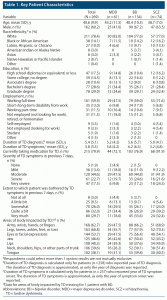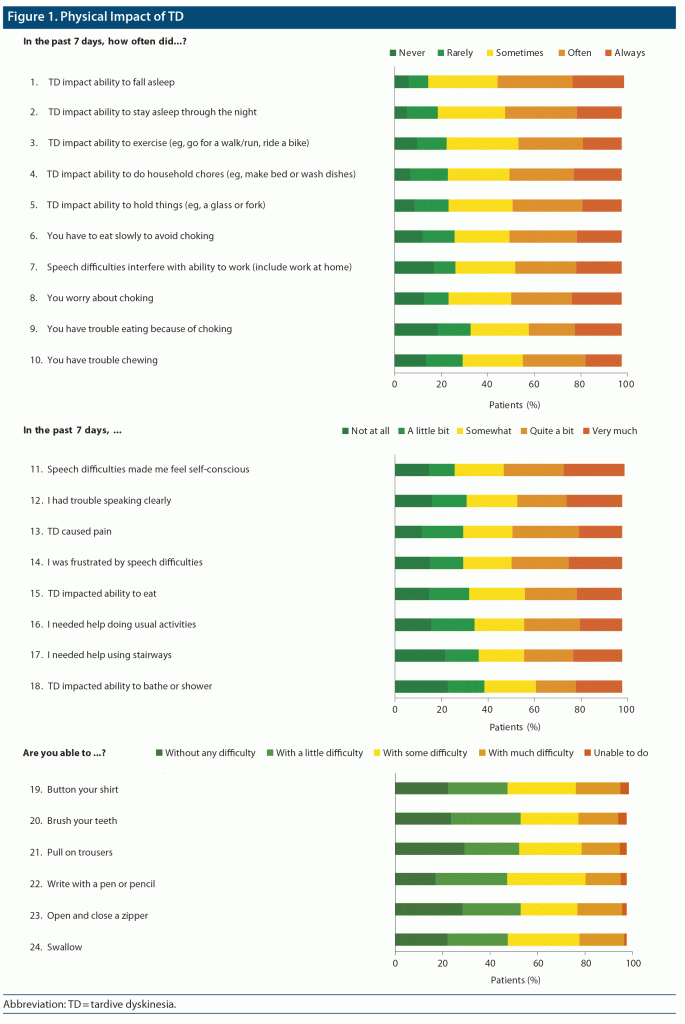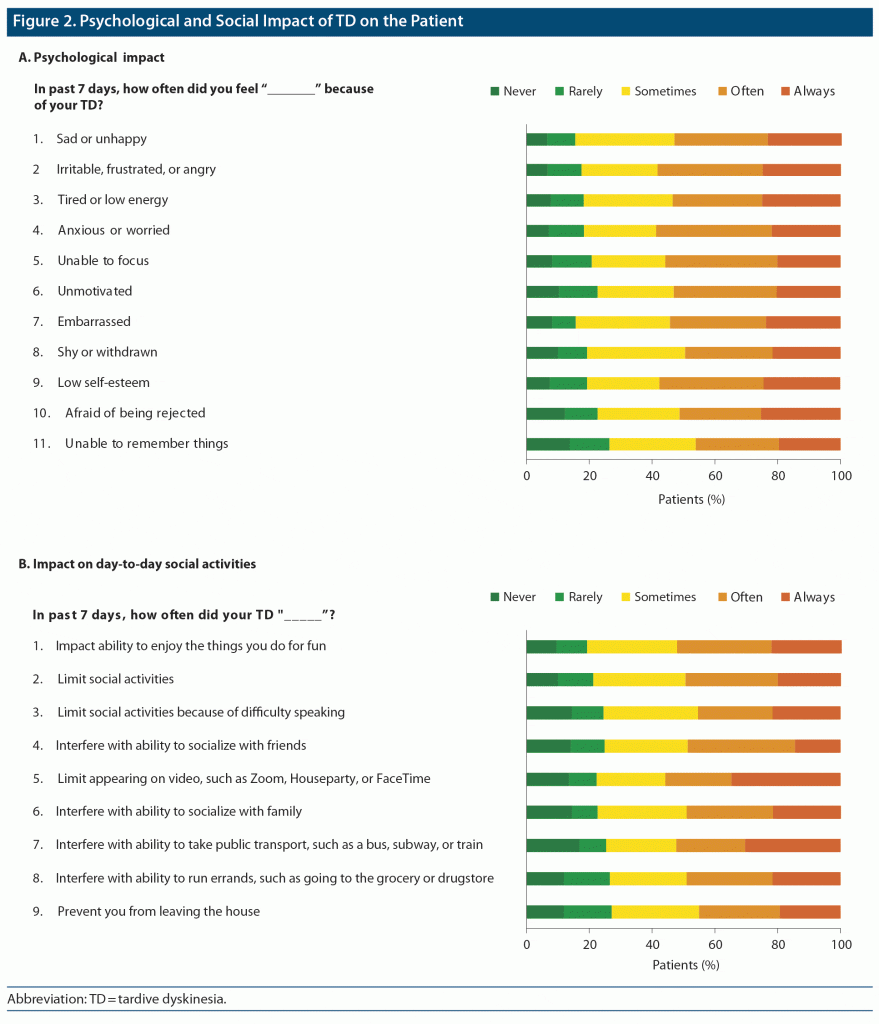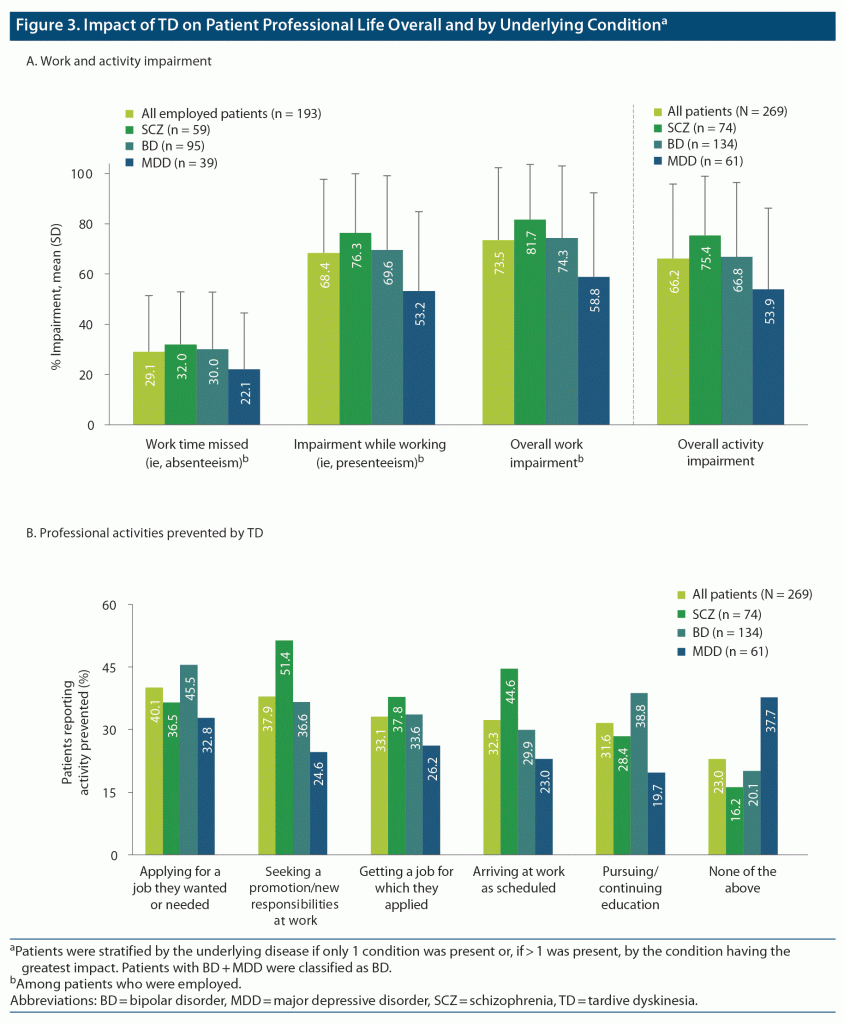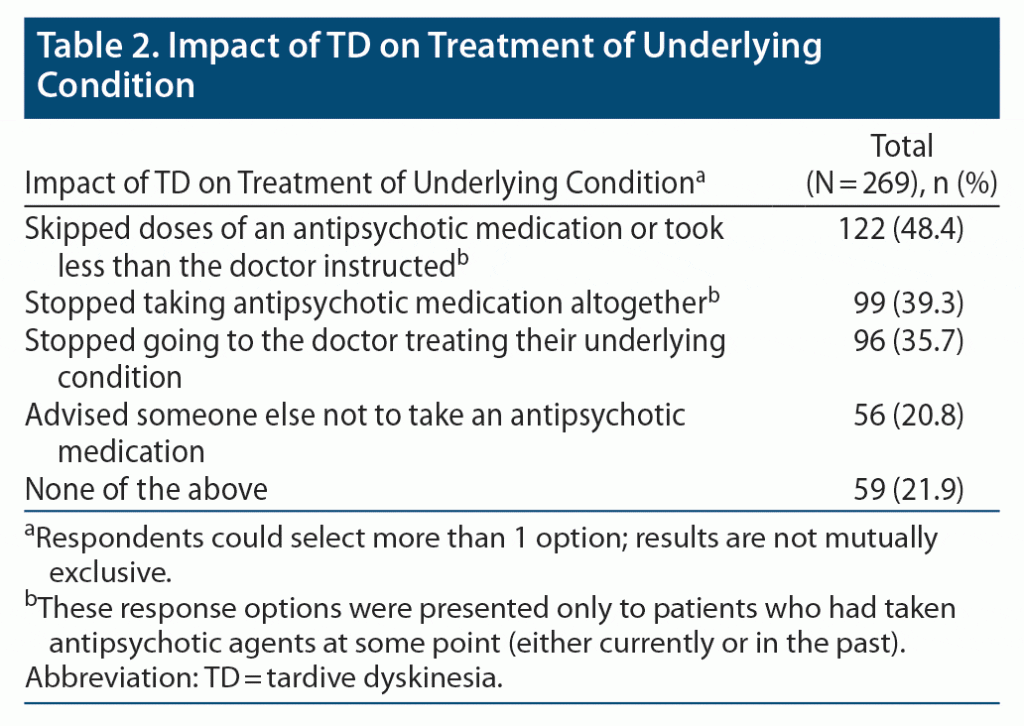https://youtu.be/MRGmsyqwobQ
ABSTRACT
Objective: To assess the physical, psychological, social, and professional impact of tardive dyskinesia (TD) on patients in the United States.
Methods: An online survey (April 2020–June 2021) to assess patient burden of TD was developed using targeted literature review and interviews with clinicians, patients, and caregivers. Survey participants (aged ≥ 18 years) with current diagnoses of TD and schizophrenia, bipolar disorder, or major depressive disorder rated the 7-day impact of TD on their physical, psychological, and social functioning via Likert scales (scored from 1 [least impact] to 5 [most impact]). Impact scores were calculated and summarized descriptively overall by self-reported disease severity and underlying disease. Participants also completed the Work Productivity and Activity Impairment Questionnaire and reported the impact of TD on their underlying psychiatric condition.
Results: Overall, 269 patients (mean [SD] age = 40.6 years [9.9]; 74.7% employed) responded to the survey. Mean (SD) impact scores of 3.1 (0.9), 3.5 (1.0), and 3.2 (1.1) were reported in the physical, psychological, and social domains, respectively, and scores increased with reported TD symptom severity. Patients with underlying schizophrenia reported the highest burden for all domains. Patients reported 66.2% activity impairment because of TD. Employed patients (n = 193) indicated 29.1% absenteeism, 68.4% presenteeism, and 73.5% overall work impairment. Over one-third of patients reported skipping/reducing (48.4%) or stopping (39.3%) their antipsychotic medication and stopping visits to clinicians treating their underlying condition (35.7%) because of TD.
Conclusion: TD imposes a substantial burden on patients’ physical, psychological, social, and professional lives and impacts management of their underlying condition.
J Clin Psychiatry 2023;84(3):22m14694
To cite: Jain R, Ayyagari R, Goldschmidt D, et al. Impact of tardive dyskinesia on physical, psychological, social, and professional domains of patient lives: a survey of patients in the United States. J Clin Psychiatry. 2023;84(3):22m14694.
To share: https://doi.org/10.4088/JCP.22m14694
© 2023 Physicians Postgraduate Press, Inc.
aDepartment of Psychiatry, Texas Tech University School of Medicine–Permian Basin, Midland, Texas
bAnalysis Group, Inc., Boston, Massachusetts
cNorth America Medical Affairs, Teva Branded Pharmaceutical Products R&D, Inc., Parsippany, New Jersey
dGlobal Health Economics and Outcomes Research, Teva Branded Pharmaceutical Products R&D, Inc., Parsippany, New Jersey
*Corresponding author: Rakesh Jain, MD, MPH, Department of Psychiatry, Texas Tech University, School of Medicine–Permian Basin, Midland, TX, United States, 2500 W William Cannon Drive, Ste 505, Austin, TX 78745 ([email protected]).
Tardive dyskinesia (TD), an iatrogenic, hyperkinetic movement disorder,1 interferes with voluntary motor functioning and evokes substantial social stigma.2 TD is characterized by abnormal involuntary movements of the head, face, trunk, and extremities.1 While the risk for TD increases with long-term use of dopamine receptor antagonists,1 TD has also been reported after short treatment periods.3
Dopamine receptor antagonists are often prescribed as antipsychotic agents for treatment of schizophrenia,4 bipolar disorder (BD),5 and major depressive disorder (MDD).6 These underlying psychiatric conditions are known to impair patient functioning in psychological, social, and professional domains in and of themselves,7 and the involuntary movements associated with TD further disrupt functioning.8–10
Patients are negatively affected by TD, especially in terms of daily activities, work productivity, social life, and self-care.9 Previous work has shown that the greatest impacts are on social functioning and physical well-being, particularly for patients with schizophrenia. The physical health effects of TD are also compounded by the presence of schizophrenia, BD, or MDD.8
This study endeavored to provide a more detailed assessment of the type of burden TD has on patients, particularly in the workplace and daily life. In addition, previous studies have utilized measurements that were not specific to TD, whereas the fit-for-purpose survey for this study was created/tailored to the TD disease state. This study used an online survey to assess the impact of TD on the physical, psychological, social, and professional functioning of patients as well as on the treatment of the patient’s underlying condition. Results of this survey are reported here.
METHODS
Study Design and Sample
Patients were recruited from patient panels maintained by the Schlesinger Group and partners (Iselin, New Jersey). These panels included patients with various health conditions across the US who have agreed to receive invitations to participate in web-based surveys. Eligible patients (aged ≥ 18 years) had current diagnoses of TD and schizophrenia, BD, or MDD. Diagnoses were self-reported by patients during the online survey. Patients were not matched by age or illness duration across underlying condition. There were no exclusion criteria for eligible patients.
An online survey (April 2020–June 2021) for patients was developed using a targeted literature review of existing publications on TD burden; one-on-one phone interviews with patients, caregivers, and health care providers about their experiences with TD; and items from the Neuro-QoL item bank,11 with minor TD-specific language adaptations. The online surveys were reviewed and tested to verify the content validity and clarity of the questionnaires. Real-time online quality checks were performed to ensure data coherence and logic. In addition, pretests were conducted with 3 eligible patients and 3 eligible caregivers to ensure that the surveys were clear and understandable. Based on inputs from the pretests, a few changes were made to further clarify the survey questions.
Patients with TD rated the 7-day impact of TD on physical, psychological, and social domains on a 5-point Likert scale. Patients also provided responses regarding the impact of TD movements on work productivity and activity impairment using the Work Productivity and Activity Impairment Questionnaire (WPAI).12 For all questions, patient-centric “anchoring” language was used to isolate the impact of TD from the underlying condition. In addition, patients reported the impact of their TD on treatment of their underlying condition. The interview guides and study protocol were approved by Western Institutional Review Board (IRB); participants provided informed consent before the interview and survey.
Procedure
Assessments. Self-reported TD impact on physical functioning (eg, dressing, eating, sleep, speech, other daily activities) was assessed using 16 questions adapted from the Neuro-QoL—5 items assessing motor skills, 7 items assessing eating, and 4 items assessing speech—and 8 additional items on other daily activities including exercise. TD impact on psychological well-being was measured with 11 questions developed from the results of qualitative interviews. TD impact on social functioning was assessed regarding 9 day-to-day social activities. Patients were also surveyed regarding how often they experienced 7 reactions of acquaintances and 4 reactions of strangers to their TD and feelings of patients in response to the reactions of 11 potential social contacts. TD impact on activities overall and professional life was assessed with the WPAI, with domain scores calculated according to the scoring manual. Bespoke questions regarding impact of TD on additional aspects of professional life and schooling were also included. Patients also reported strategies used to cope with TD movements.
Statistical analysis. All survey answers were converted to a 5-point Likert scale score (from 1 [least impact] to 5 [most impact]). A summary impact score for each domain was then calculated by summing the Likert scale values for each item in the domain and dividing the sum by the total number of questions. Subgroup analyses were conducted by underlying condition (schizophrenia, BD, MDD) and by severity of TD (no/mild/moderate, severe/very severe; based on patient self-report). Patients who reported having both BD and MDD, but not schizophrenia, were categorized as having BD. Patients with schizophrenia and BD and/or MDD were categorized based on the condition that they considered to have a greater impact on their life. If patients were unsure which condition had the greatest impact, they were categorized as having schizophrenia.
RESULTS
Patients
Overall, 269 patients responded to the survey. Because multiple recruitment sources were utilized, it was not possible to determine an accurate response rate or the underlying conditions of patients. Mean (SD) age of respondents was 40.6 (9.9) years. Over three-quarters (78.4%) of patients were White, and the majority (68.0%) had a college or postgraduate degree (Table 1). Most patients (84.8%) reported at least moderate severity of TD symptoms in the last 7 days (Table 1), with 40.2% reporting severe or very severe symptoms. Over one-quarter of patients (26.0%) reported that TD was somewhat bothersome in the last 7 days, whereas an additional 61.7% reported that TD was quite a bit/very much bothersome. Most patients (79.9%) reported taking medication for TD at the time of survey, though medication type was not recorded. The most common underlying condition reported was BD (49.8%), followed by schizophrenia (27.5%) and MDD (22.7%).
TD Overall Impact
Three-quarters of respondents (75.1%) reported severe impact (impact score ≥ 4 on ≥ 1 item within each domain) of TD across physical, psychological, and social domains. Patients who reported severe/very severe TD symptoms in the past 7 days were more likely to report severe impact in all 3 domains than patients who reported no/mild/moderate TD symptoms (95.4% vs 61.5%). Patients with schizophrenia reported severe impact across all 3 domains at a higher rate than patients with BD or MDD (86.5% vs 71.6% and 68.9%, respectively).
TD Impact on Physical Function
On a scale from 1 to 5 (with 1 being no impact and 5 being most impact), the mean (SD) physical impact score reported by patients was 3.1 (0.9) and increased with TD symptom severity (2.6 [0.8] for no/mild/moderate vs 3.7 [0.7] for severe/very severe). Scores were greater for patients with underlying schizophrenia (3.3 [0.9]) or BD (3.1 [0.9]) than with MDD (2.7 [1.0]) (Supplementary Figure 1). Over 9 in 10 patients reported that TD impacted their physical functioning, with over two-thirds reporting moderate-to-severe impact on 15 of the 24 items—(1) ability to fall asleep, (2) sleep through the night, (3) ability to exercise, (4) ability to do household chores, (5) ability to hold things, (6) needing to eat slowly to avoid choking, (7) ability to work because of speech difficulties, (8) worry about choking, (9) trouble eating because of choking, (10) trouble chewing, (11) felt self-conscious about speech difficulties, (12) trouble speaking clearly, (13) caused pain, (14) frustrated by speech difficulties, and (15) ability to eat (Figure 1).
TD Impact on Psychological Function
The mean (SD) impact score for the psychological domain was 3.5 (1.0). Like physical domain impact scores, psychological domain impact scores increased with severity of TD symptoms (3.1 [1.0] for no/mild/moderate vs 4.0 [0.7] for severe/very severe). Mean (SD) psychological domain impact scores were greater for patients with underlying schizophrenia (3.6 [0.9]) than for BD (3.5 [1.0]) or MDD (3.2 [1.0]). Across 10 of the 11 psychological domain items, over three-quarters of patients reported sometimes/often/always feeling (1) sad/unhappy; (2) irritable, frustrated, or angry; (3) tired or low energy; (4) anxious or worried; (5) unable to focus; (6) unmotivated; (7) embarrassed; (8) shy or withdrawn; (9) low self-esteem; and/or (10) afraid of being rejected (Figure 2A).
TD Impact on Social Function
The mean (SD) impact score for the social domain was 3.2 (1.1). As with physical and psychological domains, social domain impact scores increased with reported TD symptom severity (2.8 [1.0] for no/mild/moderate vs 3.9 [0.8] for severe/very severe). Social domain impact scores were also greater for patients with underlying schizophrenia (3.5 [0.9]) than for MDD (2.8 [1.1]) or BD (3.3 [1.1]).
Across 6 items assessing social impact of TD on day-to-day activities, over three-quarters of patients reported that TD sometimes/often/always impacted their ability to (1) enjoy things they do for fun, (2) join social activities, (3) join social activities because of difficulty speaking, (4) socialize with friends, (5) appear on video, and (6) socialize with family (Figure 2B).
For the 11 social impact questions addressing reactions from others, over half of patients reported that strangers (items 1–4) and acquaintances (items 1–7; Supplementary Figure 2) sometimes/often/always (1) stared/looked, (2) asked what was wrong/why they were moving, (3) told them to stop moving, (4) made jokes at their expense, (5) told them that they were different than they used to be because of TD, (6) grabbed/touched them to stop them from moving, and (7) told them that others were looking.
Over 65% of patients reported being bothered somewhat/quite a bit/very much by negative reactions from others, including their classmates (86.3%), potential spouse/partner or date (77.7%), employers (73.8%), coworkers (73.1%), friends (72.5%), other relatives (72.1%), children (71.9%), strangers that they will likely see again (71.9%), their spouse/partner (71.3%), neighbors (67.9%), and strangers they likely will not see again (65.4%).
TD Impact on Professional Function
Patients reported substantial impact of TD on their education and employment. Over 70% of patients who had TD movements while in school (n = 132) reported that TD often or always impacted their ability to do schoolwork (72.0%) and impacted it very much (72.0%). Patients who were currently employed (n = 193) reported 29.1% work time missed (ie, absenteeism calculated as missed work hours/number of scheduled work hours × 100),12 68.4% impairment while working (ie, presenteeism calculated as the degree to which the problem affected work productivity rated from 0 [no effect] to 10 [completely prevented] × 10),12 and 73.5% overall work impairment associated with TD (Figure 3A). Overall, patients reported a mean of 66.2% activity impairment (number of hours worked/number of scheduled work hours × presenteeism)12 associated with TD (Figure 3A). Mean overall activity impairment (degree to which the problem affected regular activities [eg, housework, shopping] rated from 0 [no effect] to 10 [completely prevented] × 10)12 of 75.4%, 66.8%, and 53.9% was reported in patients with TD and underlying schizophrenia, BD, and MDD, respectively.
Employed patients with schizophrenia reported the greatest impacts on work (81.7%), followed by patients with BD (74.3%) (Figure 3A). Employed patients with MDD reported less impact on work (58.8%) because of TD (Figure 3A).
At least one-quarter of patients with schizophrenia, BD, or MDD reported substantial impact of TD when applying for jobs, seeking a promotion or new responsibilities at work, and attaining a job (Figure 3B). Patients also reported interference of TD in pursuing their education and being punctual at work (Figure 3B). Patients with schizophrenia or BD reported more interference with professional initiatives than did patients with MDD (Figure 3B).
TD Impact on Management of Underlying Condition and Patient Coping Mechanisms
TD had a substantial impact on treatment of the underlying condition, with over one-third of patients skipping/reducing (48.4%) or stopping (39.3%) their antipsychotic medication and 35.7% stopping visits to clinicians treating the underlying condition (Table 2).
Patients reported multiple coping mechanisms for their involuntary movements. Common nonpharmacologic coping methods were based on voluntary muscle movement or relaxation, such as speaking more slowly (56.1%); massaging, stretching, or shaking out body parts undergoing involuntary movements (49.4%); walking around when involuntary movements start (43.1%); and doing mediation or breathing exercises (41.6%; Supplementary Table 1). Patients also reported covering their hands (43.9%) or face (32.0%) as a coping mechanism (Supplementary Table 1). Nearly half of patients also reported taking muscle relaxants (48.7%) or sleeping pills/aids (46.5%) to cope with TD symptoms (Supplementary Table 1).
DISCUSSION
TD imposes a substantial burden on patients’ physical, psychological, social, and professional functioning, regardless of underlying condition. The severity of physical, psychological, and social impact of TD was greater among patients with schizophrenia than among those with BD or MDD, consistent with reports assessing health-related quality of life in patients with these underlying conditions.8 In addition, patients reported that negative reactions of strangers and acquaintances are common, consistent with a recent survey of the general population examining the stigma associated with TD movements.2
The impact of TD reported via the WPAI on work absenteeism (29.1%), presenteeism (68.4%), and overall work impairment (73.5%) were greater than those reported for lung cancer (absenteeism, 15%; presenteeism, 31%; overall work impairment, 37%)13 and for locally recurrent or metastatic breast cancer (20%, 30%, and 40%, respectively).14 Patients with TD and MDD reported greater impact on absenteeism (22.1%), presenteeism (53.2%), and overall work impairment (58.8%) than previously recorded with the WPAI for US patients with MDD alone (absenteeism, 5.7%; presenteeism, 33.7%; and overall work impairment, 36.5%).7 Likewise, patients with TD and schizophrenia reported greater overall work impairment (81.7%) than US patients with severe schizophrenia in a recent survey.15 In this study, patients also reported that, on average, TD caused 66.2% overall activity impairment, with impairments of 75.4%, 66.8%, and 53.9% in patients with TD and underlying schizophrenia, BD, and MDD, respectively. This overall activity impairment is greater than that previously reported for schizophrenia (64%15; 56%16) and BD (48%17), but similar to that reported for MDD (59%–64%7). In addition, at least one-third of patients reported that TD prevented them from applying for a job, seeking a promotion or new responsibility at work, and/or getting a job they applied for. It is notable that the present survey was conducted during the COVID-19 pandemic; it is unknown how changes in expectations for remote work may have impacted responses.
These results highlight the multidimensional impact of TD, especially on work-related and activity-related impairment as well as on other aspects of functioning, such as psychological, physical, and social domains. On each of these domains, patients reported some degree of TD impact in their lives. Although comparisons are drawn between patients with underlying schizophrenia compared with those with BD and MDD, difficulties in everyday functioning are evident regardless of underlying condition.
Given that 79.9% of patients in this survey reported taking medication for TD at the time of the survey, the impact of TD on physical, psychological, and social domains may be even more severe in patients not currently taking medication. Importantly, patients reported that they were less likely to be adherent to antipsychotic medications. This would be expected to lead to worsening of symptoms of the underlying psychiatric illness, potentially leading to relapse,18 which is an aspect of the impact of TD that was not captured in this patient survey. It is therefore possible that some of the impact on psychological, social, and professional domains observed may have resulted indirectly from medication nonadherence.
Strengths and Limitations
While survey questions were written to ask specifically about the impact of TD (ie, anchoring), some patients may have had difficulty separating the impact of TD from those of other comorbidities. Additionally, while the online format of the survey allowed for a large sample size and anonymity, patients who responded may not be representative of the general TD population. The included patients tended to have relatively high levels of education, which may be associated with high demand for work productivity, leading to larger impacts in the professional domain than for the general TD population. The population in the current study is also notably younger, with a higher proportion of patients employed, than a distinct population of patients with TD assessed in a separate survey of caregivers (J.R., R.A., D.G., et al, unpublished data, 2023). Therefore, the study population reported here may not be representative of the general population with TD in the US. Additionally, neither the type of medication taken nor medication adherence was recorded in this study, limiting interpretation of how medications may impact TD or the underlying condition. Finally, results may be subject to recall bias. For this survey, the focus was on patients’ experiences of living with stigma. In addition, patients with mild or moderate TD may lack insight into their movements and therefore fail to recognize the presence of stigma or burden because of their TD and, therefore, do not report it in an online questionnaire. Indeed, a recent study19 indicated a divergence between real versus self-reported social function of patients with schizophrenia or BD. Moreover, this survey was conducted during the COVID-19 pandemic, which may have influenced patient experiences. Surveys have some limitations; however, in the absence of validated outcome measures, they offer the best way to assess patient burden and provide a platform for developing validated tools in the future. In addition, when standardized measures were available (ie, work impact from WPAI, and selected items from Neuro-QoL item bank), these were utilized in this study.
Conclusion and Future Directions
As evidenced by this survey, one of the largest in this disease state ever conducted, TD imposes a substantial burden on patients’ physical functioning, mental well-being, and social activities, even in patients with self-assessed mild-to-moderate TD symptoms. These results reinforce the need for health care providers to assess multiple domains of impact when assessing TD movements. These results also demonstrate that TD imposes a substantial burden on patients’ professional lives and should be taken into consideration when considering the societal burden of TD. Lastly, TD impacts how patients manage their underlying condition and can interfere with effective treatment. Further research is necessary to examine whether better TD symptom control might reduce antipsychotic treatment disruptions and nonadherence, leading to more effective treatment of the underlying psychiatric condition.
Submitted: October 18, 2022; accepted February 23, 2023.
Published online: April 3, 2023.
Author contributions: All authors, including those affiliated with the sponsor, fulfilled all authorship criteria and participated in the review and approval of the manuscript and in the decision to submit the manuscript for publication.
Relevant financial relationships: Dr Jain has received consulting fees and personal fees from and is on the speakers’ bureau and has participated in advisory boards for Adamas, Alkermes, Janssen, Lilly, Lundbeck, Merck, Neos Therapeutics, Neurocrine, Otsuka, Pamlab, Pfizer, Shire, Sunovion, Supernus, Takeda, and Teva Pharmaceuticals. Drs Ayyagari, Goldschmidt, and Zhou are employees of Analysis Group, which has received payments from Teva Branded Pharmaceutical Products R&D, Inc., in relation to this study. Drs Finkbeiner and Leo are employees and shareholders of Teva Branded Pharmaceutical Products R&D, Inc.
Funding/support: This study was funded by Teva Branded Pharmaceutical Products R&D, Inc.
Role of the sponsor: The sponsor participated in the design and conduct of the study and collection, management, analysis, and interpretation of the data, and funded the preparation of the manuscript.
Previous presentations: Presented at the 34th Annual Psych Congress; October 29–November 1, 2021; San Antonio, Texas • the 175th Annual Meeting of the American Psychiatric Association; May 21–25, 2022; New Orleans, Louisiana • the 27th Annual Meeting of the International Society for Pharmacoeconomics and Outcomes Research; May 15–18, 2022; Washington, DC.
Acknowledgments: Medical writing and editorial support were provided by Holly Engelman, PhD; Jennifer C. Jaworski, MS, BCMAS; and Kelsey Hogan, MS, all of Ashfield MedComms, an Inizio company, and was funded by Teva Branded Pharmaceutical Products R&D, Inc.
Supplementary material: Available at Psychiatrist.com.
CLINICAL POINTS
- Data are limited on how tardive dyskinesia (TD) impact patients’ physical, social, emotional, and professional functioning as well as on differences in impact across different underlying conditions.
- This survey provided additional detail about how TD affects patients’ physical functioning, mental well-being, and workplace performance as well as their social interactions, including the impact of stigma.
References (19)

- Cornett EM, Novitch M, Kaye AD, et al. Medication-induced tardive dyskinesia: a review and update. Ochsner J. 2017;17(2):162–174. PubMed
- Ayyagari R, Goldschmidt D, Mu F, et al. An experimental study to assess the professional and social consequences of tardive dyskinesia. Clin Psychopharmacol Neurosci. 2022;20(1):154–166. PubMed CrossRef
- Frei K. Tardive dyskinesia: Who gets it and why. Parkinsonism Relat Disord. 2019;59:151–154. PubMed CrossRef
- Hui CLM, Lam BST, Lee EHM, et al. A systematic review of clinical guidelines on choice, dose, and duration of antipsychotics treatment in first- and multi-episode schizophrenia. Int Rev Psychiatry. 2019;31(5–6):441–459. PubMed CrossRef
- Pacchiarotti I, Tiihonen J, Kotzalidis GD, et al. Long-acting injectable antipsychotics (LAIs) for maintenance treatment of bipolar and schizoaffective disorders: a systematic review. Eur Neuropsychopharmacol. 2019;29(4):457–470. PubMed CrossRef
- Wang P, Si T. Use of antipsychotics in the treatment of depressive disorders. Shanghai Jingshen Yixue. 2013;25(3):134–140. PubMed
- Lam RW, Lamy FX, Danchenko N, et al. Psychometric validation of the Perceived Deficits Questionnaire-Depression (PDQ-D) instrument in US and UK respondents with major depressive disorder. Neuropsychiatr Dis Treat. 2018;14:2861–2877. PubMed CrossRef
- McEvoy J, Gandhi SK, Rizio AA, et al. Effect of tardive dyskinesia on quality of life in patients with bipolar disorder, major depressive disorder, and schizophrenia. Qual Life Res. 2019;28(12):3303–3312. PubMed CrossRef
- Caroff SN, Yeomans K, Lenderking WR, et al. RE-KINECT: a prospective study of the presence and healthcare burden of tardive dyskinesia in clinical practice settings. J Clin Psychopharmacol. 2020;40(3):259–268. PubMed CrossRef
- Strassnig M, Rosenfeld A, Harvey PD. Tardive dyskinesia: motor system impairments, cognition and everyday functioning. CNS Spectr. 2018;23(6):370–377. PubMed CrossRef
- Gershon RC, Lai JS, Bode R, et al. Neuro-QOL: quality of life item banks for adults with neurological disorders: item development and calibrations based upon clinical and general population testing. Qual Life Res. 2012;21(3):475–486. PubMed CrossRef
- Reilly MC, Zbrozek AS, Dukes EM. The validity and reproducibility of a work productivity and activity impairment instrument. Pharmacoeconomics. 1993;4(5):353–365. PubMed CrossRef
- Wood R, Taylor-Stokes G, Smith F, et al. The humanistic burden of advanced non-small cell lung cancer (NSCLC) in Europe: a real-world survey linking patient clinical factors to patient and caregiver burden. Qual Life Res. 2019;28(7):1849–1861. PubMed CrossRef
- Cleeland CS, Mayer M, Dreyer NA, et al. Impact of symptom burden on work-related abilities in patients with locally recurrent or metastatic breast cancer: Results from a substudy of the VIRGO observational cohort study. Breast. 2014;23(6):763–769. PubMed CrossRef
- Kadakia A, Fan Q, Shepherd J, et al. Point-in-time survey of healthcare resource utilization, employment, quality of life and caregiver status by disease severity in patients with schizophrenia in the US. Curr Med Res Opin. 2022;38(3):469–478. PubMed CrossRef
- Fitzgerald HM, Shepherd J, Bailey H, et al. Treatment goals in schizophrenia: a real-world survey of patients, psychiatrists, and caregivers in the United States, with an analysis of current treatment (long-acting injectable vs oral antipsychotics) and goal selection. Neuropsychiatr Dis Treat. 2021;17:3215–3228. PubMed CrossRef
- Kato T, Baba K, Guo W, et al. Impact of bipolar disorder on health-related quality of life and work productivity: estimates from the national health and wellness survey in Japan. J Affect Disord. 2021;295:203–214. PubMed CrossRef
- Jackson R, Brams MN, Citrome L, et al. Assessment of the impact of tardive dyskinesia in clinical practice: consensus panel recommendations. Neuropsychiatr Dis Treat. 2021;17:1589–1597. PubMed CrossRef
- Durand D, Strassnig MT, Moore RC, et al. Self-reported social functioning and social cognition in schizophrenia and bipolar disorder: Using ecological momentary assessment to identify the origin of bias. Schizophr Res. 2021;230:17–23. PubMed CrossRef
This PDF is free for all visitors!
Save
Cite
